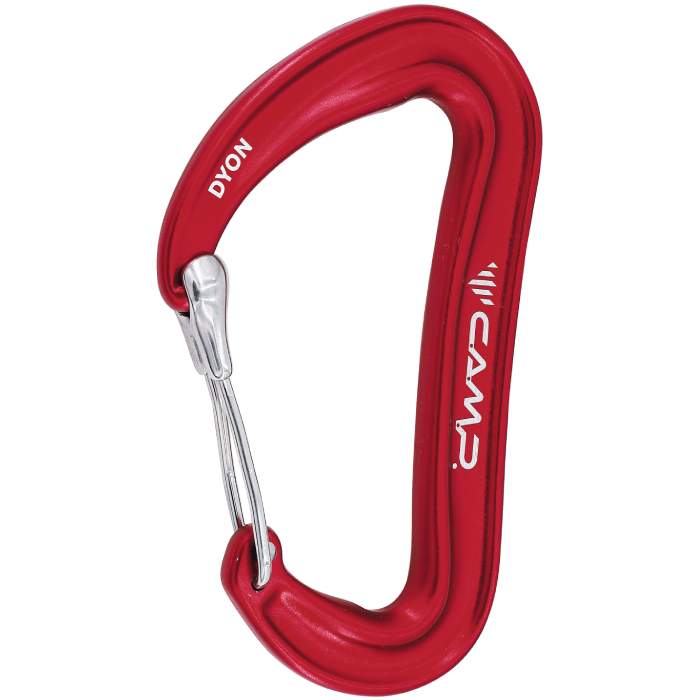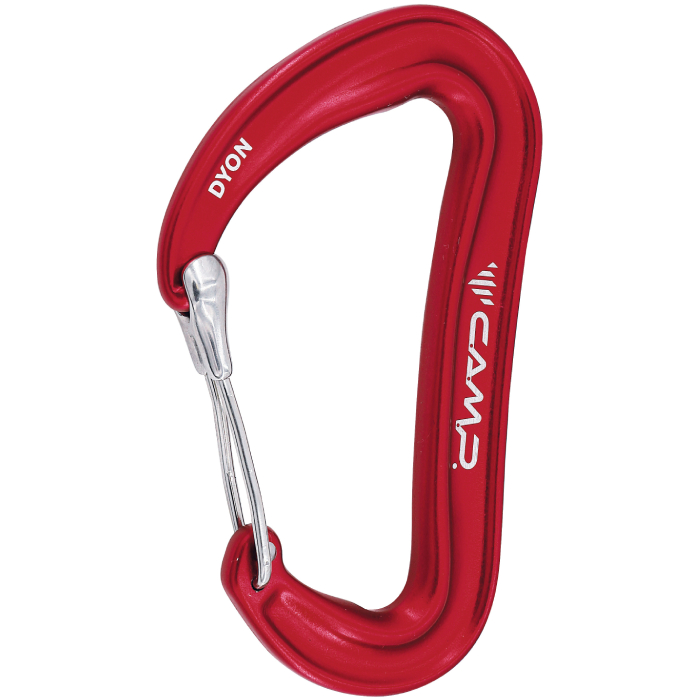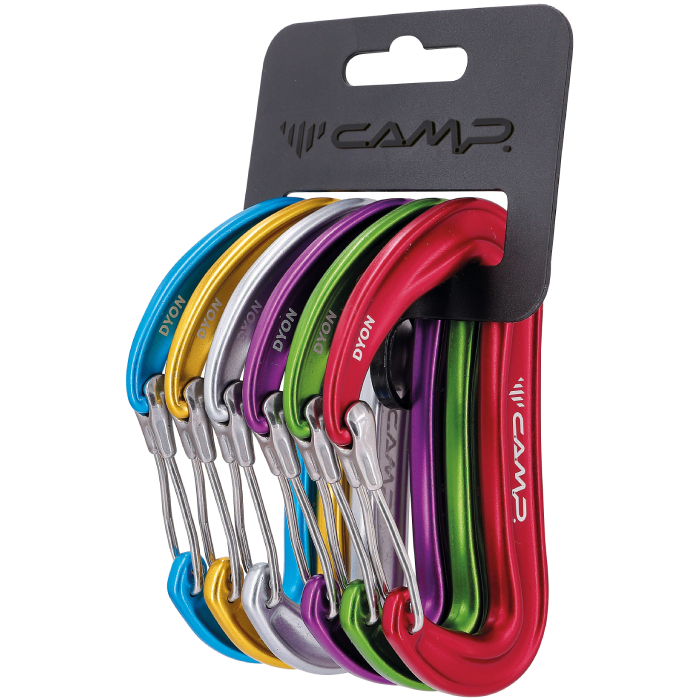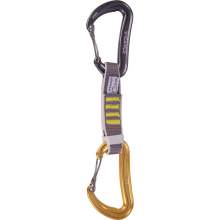Dyon
Description
- New patented KeyWire design combines the benefits of wire gate action with a keylocking closure
- Patented SphereLock closure minimizes play between the gate and nose for enhanced safety and performance
- Curved I-Beam construction on the spine creates a very high open gate strength
- 8 colors coordinate with the most popular cam colors
Another step forward in carabiner evolution, the Dyon uses a proprietary two-part gate to combine the benefits of smooth wire gate action with a keylocking closure. This unique combination gives it both high levels of performance and safety. The curved I-Beam construction on the spine keeps the weight to a minimum while providing a high level of rigidity and an incredible open gate strength of 11 kN. The patented SphereLock closure minimizes play between the gate and nose for enhanced safety and performance. Available in 8 colors to coordinate with the most popular cam colors.
Retail price
When you click a link below and then checkout online, no matter what you buy (climbing gear or not), we get a small commission that helps us keep this site up-to-date. Thanks!
Weight (g)  Weight (g)In grams, the weight, as stated by the manufacturer/brand. |
33 g |
Shape  ShapeRule of thumbAlmost every carabiner you use will be non-locking offset D’s, with the exception of a Pear/HMS locker as your belay ‘biner. Offset D (aka Modified D)60% of the market 
A modification of the standard D shape, the top of an offset D is much wider, allowing for a larger (and superior) gate opening. When loaded, most of the weight is transferred to the spine of the carabiner making them stronger than most other shapes. Used for top and bottom quickdraws, as racking carabiners, and lightweight lockers. Pear / HMS22% of the market 
The Pear/HMS carabiner is used primarily for belaying and/or setting a powerpoint in an anchor. The wide top means they can hold a lot of gear. They are almost always locking and are generally heavier (than D/offset D's) because they need more material to gain back strength lost due to their shape. Oval8% of the market 
The first carabiner shape to be mass produced. When loaded, the pressure is shared equally on both sides of the ‘biner. Since the weaker gate shares the load with the spine, oval biners aren’t as strong as shapes that direct the load to the spine. The bonus is, your gear rests squarely in the middle, so it's great for holding nuts, pulleys, and prusiks. D (aka symmetric D)7% of the market 
D’s have a symmetrical shape that sets the rope closer to the spine, putting the load on the spine (versus sharing the load with the weaker gate side, like the oval). Since the strongest part of the carabiner carries the weight, D’s are the strongest shape. Downside: Smaller gate openings than the offset D. Quick Link (aka Oval link, Maillon Raptide)1% of the market 
Although most climbers wouldn’t refer to this shape as a “carabiner” they are certified by the same EN standard as all the other carabiners. These semi-permanent links ensure the gate will not accidentally open. They're used when setting up a semi-permanent rappel station (not used while climbing up). Semi-Circle / 3Dless than 1% of the market 
Semi-circle: Mostly used by Search and Rescue as this is a great way to secure a chest harness. Learn More
Pros and cons of each shape, graphs and more examples |
D / Offset D |
Locking  Lockingmain non-locking carabiners uses:
main locking carabiners uses:
screw gate vs auto-locking gateScrew gates are generally lighter and cheaper. Auto-locking gates are usually considered safer as they automatically snap shut, not counting on one's memory to close and are harder to accidentally unlock. The debate comes on opening speed as some are much faster while others can be a struggle. Learn More
See the newest auto-locking gate technologies |
No |
Straight or Bent  Straight or BentIt's easier to see the difference between straight and bent gates on solid gate carabiners: 
Straight GateThe standard. Always used as the bolt-end of the quickdraw, and still sometimes used on the rope-side too. Also used for racking gear such as cam and nuts. Bent GateCreated to make it easier to put the rope into a quickdraw with their larger gate opening. Primarily used on the rope-end (bottom) of quickdraws. Extra Notes
Important NoteMany manufacturers are now making the bolt-end carabiner come standard in silver (to match the bolt color), and are coloring the rope-end with other anodizations. Do not mix (interchange) bolt-end carabiners and rope-end carabiners. This can be very dangerous as small abrasions made by the bolt can easily wear your rope. DMM put out a great video/write-up on this issue. |
Straight |
Full Size  Full SizeFull size carabiners are easier to hold but generally they're also heavier. This is a totally debatable field as there is no official size, weight, or gate opening necessary to be full size. There are no certifications and this isn't a standard the manufacturer's normally describe specifically. We did our best to compare (descriptions, in-person use, etc), as a way to help give more information about this carabiner. Like always, if you see something that seems totally off, send us a note. |
Yes |
Keylock  KeylockA keylock nose means the nose is smooth. Keylock carabiners are also known as: snag-free, notch-less, and hook-less. 
Keylock BenefitThe lack of a hooked nose makes for less snagging on gear and bolts – a dramatic improvement. Keylock DrawbackGiven that they’re more complicated to manufacture, keylock designs often come at a higher price, especially in wiregates. Worth ConsideringThere are more design features necessary to guarantee a snag-free experience, like the curvature of the nose. Some keylock carabiners will still catch on the nose because of the lack of a smooth nose arc (smoother the arc, smoother the clip). Learn More
Check out our blogpost that goes over carabiner nose design to get all the details |
Yes |
Solid or Wire  Solid or Wire
Solid GatesGenerally on beefier carabiners, so they're usually heavier and more durable. They can also feel more substantial in your hands while clipping. Often favored by sport climbers. Wire GatesFeatured on the lightest carabiners, so they're favored by trad and alpine climbers. Some considerationsIf you want keylock nose carabiners, then solid gates will be much cheaper compared to wire gates. When wiregates first came out they were not trusted (too new, looked too simple). Now, it's proven that wiregates have less gate flutter and gate shutter than solid gates. Learn More
Compare gate flutter and gate shutter |
Wire |
Gate Opening  Gate Opening (mm)Gate opening refers to the distance between a carabiner’s nose and the fully open gate. 
General Guidelinestop of your quickdraw: 17 mm – 22 mm Adding bias towards a larger gate opening is a great option once you’ve narrowed your choice to a few similar carabiners and need help determining which one is the best. Learn More
Gate opening comparisons, examples, averages, shape, sizes, graphs, and explanations |
26 mm |
Number of Colors  Number of ColorsThe number of different colors that you can find this carabiner in. This color-coding practice was started with just 2 colors, usually silver (that goes on the bolt side of a quickdraw) and another color for the rope side. Now, carabiners come in 5+ colors sets known as "rack packs" so your carabiners can match your cams. Climbers can also match their carabiner color to their harness or other gear just for fun. Learn MoreCarabiner Rack Packs Explained |
8 |
Lock Indicator  Visual Warning
A lock indicator is a visual warning only seen on locking carabiners. It adds some sort of visual to show if the carabiner is unlocked such as the color red, a danger sign, an unlocked image, etc. When the carabiner is locked the visual indicator is hidden. Only a small list of manufacturers add this safety feature, although you can easily add one yourself with a permanent marker. |
No |
Strengths (kN)  Strengths (kN)In kilonewtons, the strength, as stated by the manufacturer/brand. Major Axis Closed Gate Strength
This is the strongest orientation and the way carabiners are designed to be loaded. Major Axis Open Gate Strength
This strength is measured because while climbing, carabiners lying against the rock can be opened slightly as they move across an uneven surface. A carabiner can also open slightly during a fall as the ‘biner starts to vibrate, dispersing the energy (also called "gate flutter"). A weak gate closure (due to a poor/failing spring or an over-stressed wire) could also leave the gate ajar. Minor Axis Gate Strength
Carabiners are not intended to be loaded along the minor axis (cross-loaded), but it is possible for a carabiner to unintentionally rotate during use, especially while belaying. Of all accidental misuses of a carabiner, cross-loading is the most frequent suspect, which is why there is a rating for it. Generally wire gates are stronger than solid gates in the minor axis. During the test, the wire gate bends, absorbing some of the force, as compared to a less pliable solid gate. Learn More
How carabiners are rated, recommendations and strengths. | |
Narrow nose
by Benjamin VanderStouw on 03/29/2020The Dyon is an excellent carabiner. The operation is smooth throughout applications and will be appreciated by the leader just as much as the follower because of its unique snag free keylock gate and smooth nose. We put a significant amount of time into finding a problem with this carabiner but came up mostly empty-handed. If we wanted to be really picky, we would point out the 3kn of strength lost by putting a concave bend in the spine, but 21kn is strong. Yes there is a steep cost to get into the Dyon game but once you're in there, you are sure to have a good time.
In use, the Dyon is a pleasure to handle, with or without gloves. The gate is large enough to easily open with cold fingers encased in thick gloves, and the biner is a cinch to clip to screws, bolts or gear loops. I’ve not had it come even close to freezing up, despite the whole draw becoming encased in ice.
The Dyon overall has a great ergonomic feel to it. The gate is stiff and smooth (much stiffer than the Photon Wiregate) The size is nice, and the biner weighs a fairly impressive 33g (for comparison, the CAMP Photon weighs 29g and the Black Diamond Hotwire weighs 43g.) I loved the size of the nose—it felt great when unclipping it from bolts.
The UIAA equipment standard provides a baseline for equipment performance in a test lab under controlled conditions on new equipment. Although these test conditions are relevant to the conditions encountered climbing, conditions encountered at the crags and the condition of the equipment are equally important. This recommendation from the UIAA member federation The British Mountaineering Council (BMC) provides vital equipment information that is NOT explicitly addressed in the standard, particularly failure modes of the equipment and recommendations for the use, inspection, maintenance, and retirement of equipment.
A pictoral representation of UIAA-121 and EN-12275 standards for connectors (the UIAA's fancy word for carabiners).






































